英语教学设计大赛模板
英语大赛优秀教案范文模板
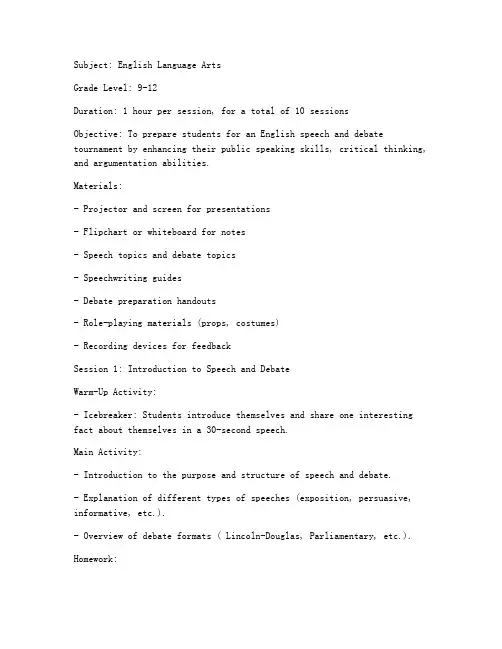
Subject: English Language ArtsGrade Level: 9-12Duration: 1 hour per session, for a total of 10 sessionsObjective: To prepare students for an English speech and debate tournament by enhancing their public speaking skills, critical thinking, and argumentation abilities.Materials:- Projector and screen for presentations- Flipchart or whiteboard for notes- Speech topics and debate topics- Speechwriting guides- Debate preparation handouts- Role-playing materials (props, costumes)- Recording devices for feedbackSession 1: Introduction to Speech and DebateWarm-Up Activity:- Icebreaker: Students introduce themselves and share one interesting fact about themselves in a 30-second speech.Main Activity:- Introduction to the purpose and structure of speech and debate.- Explanation of different types of speeches (exposition, persuasive, informative, etc.).- Overview of debate formats ( Lincoln-Douglas, Parliamentary, etc.).Homework:- Research a famous speech and write a brief analysis of its structure and effectiveness.Session 2: Speech Writing and DeliveryWarm-Up Activity:- Group activity: Students practice delivering a 30-second speech on a given topic.Main Activity:- Discussion on the importance of clear structure and compelling language in speech writing.- Hands-on activity: Students create a speech outline and write a draft based on the outline.- Delivery tips and techniques, including voice projection, body language, and audience engagement.Homework:- Write a full speech based on the outline created in class, focusing on persuasive techniques.Session 3: Critical Thinking and ArgumentationWarm-Up Activity:- Brainstorming session: Students list reasons for and against a given topic.Main Activity:- Introduction to critical thinking skills necessary for effective argumentation.- Analysis of logical fallacies and how to avoid them.- Practice in constructing strong arguments and counterarguments.Homework:- Write a short argumentative essay on a class-selected topic, identifying and refuting potential logical fallacies.Session 4: Practicing Delivery SkillsWarm-Up Activity:- Role-playing: Students act out a speech, receiving feedback on delivery.Main Activity:- Practicing delivery in front of the class, with peers providing constructive criticism.- Video recording and playback to analyze strengths and areas for improvement.Homework:- Review video feedback and revise the speech accordingly.Session 5: Debate PreparationWarm-Up Activity:- Practice debate format: students engage in a short debate on a class-selected topic.Main Activity:- In-depth discussion on the preparation process for debates, including research, note-taking, and strategy development.- Role-playing different positions in a debate to understand the perspectives of both sides.Homework:- Research and prepare arguments for a debate topic, selecting a position and gathering evidence.Session 6: Debating in ActionWarm-Up Activity:- Practice debates with peers, focusing on refining argumentation skills.Main Activity:- Full-scale debate among students, with each student taking a side and presenting their arguments.- Peer evaluation and feedback.Homework:- Reflect on the debate experience and write a brief summary of the key points discussed.Session 7: Advanced Public Speaking TechniquesWarm-Up Activity:- Group activity: Students practice delivering a speech with a unique structure (e.g., storytelling, metaphorical).Main Activity:- Advanced techniques for public speaking, including the use of humor, anecdotes, and persuasive language.- Hands-on practice in incorporating these techniques into a speech.Homework:- Write a speech incorporating at least two advanced public speaking techniques.Session 8: Speech and Debate EthicsWarm-Up Activity:- Role-playing scenario: Students act out a situation involving ethical considerations in speech and debate.Main Activity:- Discussion on the importance of ethics in speech and debate, including honesty, respect, and fairness.- Analysis of real-life ethical dilemmas in speech and debate.Homework:- Write an essay on the ethical considerations involved in speech and debate.Session 9: Final Rehearsal and PreparationWarm-Up Activity:- Group activity: Students practice delivering their final speeches and debates.Main Activity:- Final preparation for the tournament, including dress rehearsal and final feedback.- Encouragement and motivation to perform well.Homework:- Review feedback and finalize speeches and debate arguments.Session 10: Tournament DayWarm-Up Activity:- Final motivational speech and group discussion on how to handle the tournament experience.Main Activity:- Students participate in the English speech and debate tournament.- Peer support and encouragement during the competition.Assessment:- Evaluation of speech and debate performances based on preparedness, content, delivery, and teamwork.- Feedback from peers and teachers to help students reflect on their performance and areas for future improvement.。
外语教学比赛教案模板范文
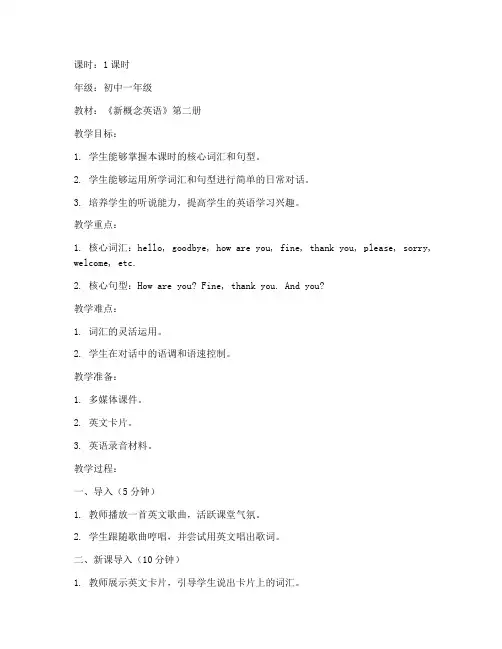
课时:1课时年级:初中一年级教材:《新概念英语》第二册教学目标:1. 学生能够掌握本课时的核心词汇和句型。
2. 学生能够运用所学词汇和句型进行简单的日常对话。
3. 培养学生的听说能力,提高学生的英语学习兴趣。
教学重点:1. 核心词汇:hello, goodbye, how are you, fine, thank you, please, sorry, welcome, etc.2. 核心句型:How are you? Fine, thank you. And you?教学难点:1. 词汇的灵活运用。
2. 学生在对话中的语调和语速控制。
教学准备:1. 多媒体课件。
2. 英文卡片。
3. 英语录音材料。
教学过程:一、导入(5分钟)1. 教师播放一首英文歌曲,活跃课堂气氛。
2. 学生跟随歌曲哼唱,并尝试用英文唱出歌词。
二、新课导入(10分钟)1. 教师展示英文卡片,引导学生说出卡片上的词汇。
2. 教师带领学生复习已学过的核心词汇和句型。
三、课堂活动(20分钟)1. 小组对话练习a. 将学生分成若干小组,每组选一个组长。
b. 组长带领小组成员进行对话练习,话题可以是自我介绍、问候等。
c. 教师巡回指导,纠正学生的发音和语法错误。
2. 游戏活动a. 教师将学生分成两组,进行“猜词游戏”。
b. 一组学生用手势和表情描述一个单词,另一组学生猜测这个单词。
c. 猜对单词的小组获得一分,最后得分高的小组获胜。
四、巩固练习(10分钟)1. 教师播放录音材料,学生跟读并模仿录音中的发音和语调。
2. 学生进行角色扮演,练习对话。
五、总结与作业(5分钟)1. 教师总结本节课所学内容,强调重点词汇和句型。
2. 布置作业:让学生回家后,与家人用英语进行对话练习,巩固所学知识。
教学反思:本节课通过歌曲导入、词汇复习、小组对话练习、游戏活动等多种教学手段,激发学生的学习兴趣,提高学生的听说能力。
在教学过程中,教师要注意关注学生的个体差异,针对不同学生的学习情况给予针对性的指导。
英语教学教案模板英文版(10篇)
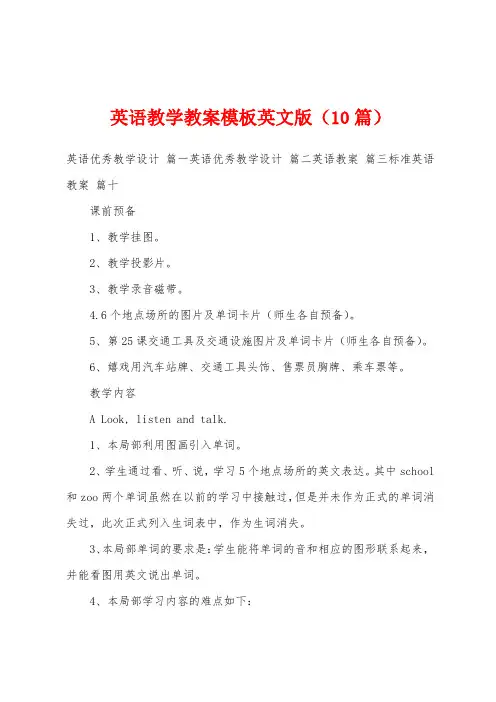
英语教学教案模板英文版(10篇)英语优秀教学设计篇一英语优秀教学设计篇二英语教案篇三标准英语教案篇十课前预备1、教学挂图。
2、教学投影片。
3、教学录音磁带。
4.6个地点场所的图片及单词卡片(师生各自预备)。
5、第25课交通工具及交通设施图片及单词卡片(师生各自预备)。
6、嬉戏用汽车站牌、交通工具头饰、售票员胸牌、乘车票等。
教学内容A Look, listen and talk.1、本局部利用图画引入单词。
2、学生通过看、听、说,学习5个地点场所的英文表达。
其中school 和zoo两个单词虽然在以前的学习中接触过,但是并未作为正式的单词消失过,此次正式列入生词表中,作为生词消失。
3、本局部单词的要求是:学生能将单词的音和相应的图形联系起来,并能看图用英文说出单词。
4、本局部学习内容的难点如下:(1)book store词组中失去爆破的读音;(2)地点及场所单词词义的识别。
5、初步练习用“Where are you going? Im going to.。
.。
”语句,询问某人要去哪儿和表达自己要去的地方。
6、初步练习询问某人乘坐什么交通工具并能答复。
7、本局部重点学习地点及场所单词的音、形、义/对语句的学习仅要求能初步感知,在B局部教学中应留意进展语句的稳固练习。
8、本局部能够涉及到的复习内容是:询问某物在哪儿的语句及表示方位的词。
此项复习内容为第27课学习指路和问路做了铺垫。
B Lets play and say.1、本局部的学习内容是学生通过嬉戏的方式进展模拟角色表演。
2、学生通过用语言做事情,娴熟把握所学地点场所的单词和询问某人要去哪儿的问答语。
3、本局部有一首关于开着车去某地方的。
歌曲,此歌曲协作学生模拟活动,不要求学生会唱,可以在今后的复习稳固中要求学生逐步学会此歌曲。
教学建议1、学生在学习新内容之前,教师应帮忙学生对第25课的学习内容进展复习。
2、教师出示教学挂图,请学生看图并听录音。
大赛英语教案模板范文
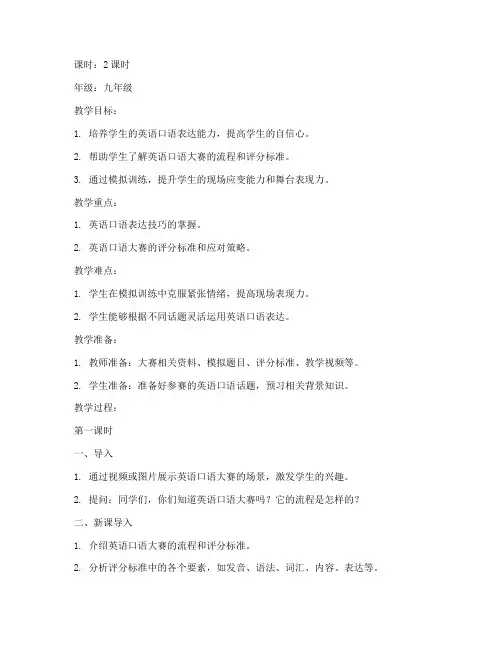
课时:2课时年级:九年级教学目标:1. 培养学生的英语口语表达能力,提高学生的自信心。
2. 帮助学生了解英语口语大赛的流程和评分标准。
3. 通过模拟训练,提升学生的现场应变能力和舞台表现力。
教学重点:1. 英语口语表达技巧的掌握。
2. 英语口语大赛的评分标准和应对策略。
教学难点:1. 学生在模拟训练中克服紧张情绪,提高现场表现力。
2. 学生能够根据不同话题灵活运用英语口语表达。
教学准备:1. 教师准备:大赛相关资料、模拟题目、评分标准、教学视频等。
2. 学生准备:准备好参赛的英语口语话题,预习相关背景知识。
教学过程:第一课时一、导入1. 通过视频或图片展示英语口语大赛的场景,激发学生的兴趣。
2. 提问:同学们,你们知道英语口语大赛吗?它的流程是怎样的?二、新课导入1. 介绍英语口语大赛的流程和评分标准。
2. 分析评分标准中的各个要素,如发音、语法、词汇、内容、表达等。
三、口语表达技巧训练1. 发音训练:通过视频或音频,让学生跟读、模仿,纠正发音错误。
2. 语法和词汇训练:通过练习题,让学生巩固和运用常用语法和词汇。
3. 内容组织训练:引导学生根据话题,组织语言,构建完整的表达结构。
四、模拟训练1. 将学生分成小组,每组选择一个话题进行模拟对话。
2. 教师巡回指导,帮助学生克服紧张情绪,提高现场表现力。
第二课时一、复习1. 复习上节课学习的口语表达技巧。
2. 学生分享模拟训练中的收获和不足。
二、实战演练1. 学生根据准备好的话题,进行实战演练。
2. 教师点评,指出学生的优点和不足,给予改进建议。
三、总结1. 总结英语口语大赛的应对策略。
2. 鼓励学生积极参与英语口语活动,提高自己的英语水平。
教学反思:1. 关注学生在口语表达中的情感体验,引导学生克服紧张情绪。
2. 结合学生的实际水平,调整教学策略,提高教学效果。
3. 鼓励学生积极参与英语口语大赛,提高自己的英语口语表达能力。
英语专业优秀教学设计一等奖5篇
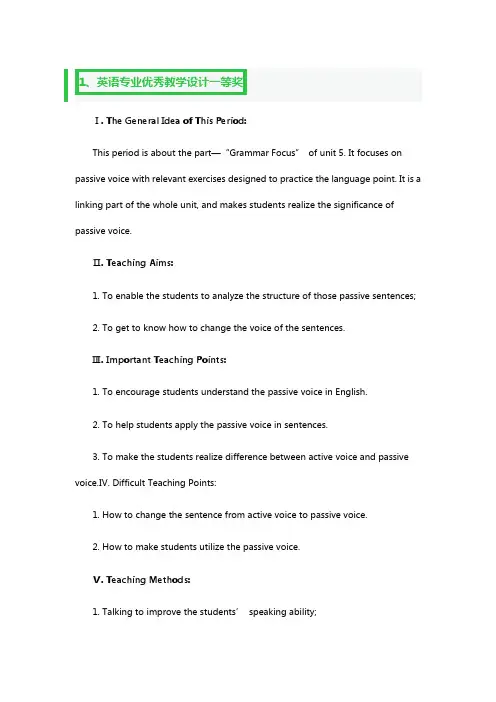
1、英语专业优秀教学设计一等奖Ⅰ. The General Idea of This Period:This period is about the part—“Grammar Focus”of unit 5. It focuses on passive voice with relevant exercises designed to practice the language point. It is a linking part of the whole unit, and makes students realize the significance of passive voice.Ⅱ. Teaching Aims:1. To enable the students to analyze the structure of those passive sentences;2. To get to know how to change the voice of the sentences.Ⅲ. Important Teaching Points:1. To encourage students understand the passive voice in English.2. To help students apply the passive voice in sentences.3. To make the students realize difference between active voice and passive voice.Ⅳ. Difficult Teaching Points:1. How to change the sentence from active voice to passive voice.2. How to make students utilize the passive voice.Ⅴ. Teaching Methods:1. Talking to improve the students’speaking ability;2. Situational dialogue to arouse the interest of students;3. Discussion to make every student work in class.Ⅵ. Teaching Aids:1. The multimedia2. The blackboardⅦ. Teaching Procedures:Step1 Lead-in1. Greet the whole class as usual.T: Class begins! Good morning everyone! Sit down, please! Today, we will come to learn Unit5, grammar focus, passive voice. Take it easy! Firstly, we will watcha short film from the “Freaky Friday”.2. Review a short video from the film (Freaky Friday) we have watched.(1) Ask Students to act the film.(2) The others talk about what they are doing.T: can you remember the last four sentences of the video? (Play the slides) And try to imitate these sentences with me, OK? (Practice for 3 times) Now, try to role play in pair. OK, go!3. Review the passive sentences we have learned in this unit.(1) Read the passive sentences on the screen.(2) Try to find out the model of the passive sentences.Step 2 Grammar learning1. Structure of passive sentencesT: As we all know, sentences can be divided into passive voice sentences and active voice sentences. What is the similarity of these sentences?Active voice(On the blackboard) VoicePassive voiceT: As we can see, the structure is like “be + v-pp”(write on the blackboard). T: We have just mentioned, “我乘坐机车是不被允许的`”how to say?T: Then,”抽烟是不被允许的”how to say?(play the slide)T: Let’s see some past participant of some usual verbs. There are three types changes of v-pp. (play the slides)T: The jacket _____ (make) wool. (Play the slides).A bank _____ (rob) yesterday. (Play the slides).The rice _____ (grow) in China. (Play the slides).T: OK, turn to page 36, group4 and group5 read the questions, and group 1/2/3read the answers. Clear? Are you…ready go!2. Voice exchange(1) Simple sentence “刘谦变魔术”how to say?(Play the slide) Then, how tochange it into passive voice?(2) 4 steps of change the voice of a sentence. (Play the slides)(3) Many people speak English all over the world. (Demonstrate the 4 steps onthe blackboard)Step 3 practiceT: Until now, we have learned the way of change the voice of a sentence. Do you know how to do it?T: According to the four steps, we can rewrite following sentences. And try to finish 4b in groups, OK?T: OK, let’s check the answer.T: Let’s do some exercises to apply the passive voice in sentences. (Show them some photos of their everyday activities and give them some help in necessary.) Try to describe the picture by two voices; you can do it in pairs. OK, go!T: Who would like to share your answer with us? (Point 4-5 pairs)Step 4 Homework1. Finish the Section A of the Exercise book;2. Prepare for the dictation.2、英语专业优秀教学设计一等奖一、教学内容:Lesson 6 Fruits二、教学目标:1、能听懂会说单词:orange , apple , peach , watermelon , pear , grapes , banana .2、能听懂句子进行会话:3、通过创设情境,使学生感受并运用语言,进一步培养学生口语交际能力。
教案设计英语比赛模板范文
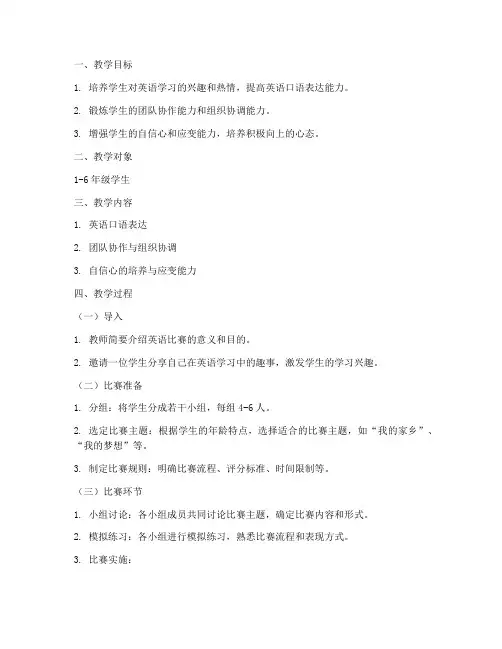
一、教学目标1. 培养学生对英语学习的兴趣和热情,提高英语口语表达能力。
2. 锻炼学生的团队协作能力和组织协调能力。
3. 增强学生的自信心和应变能力,培养积极向上的心态。
二、教学对象1-6年级学生三、教学内容1. 英语口语表达2. 团队协作与组织协调3. 自信心的培养与应变能力四、教学过程(一)导入1. 教师简要介绍英语比赛的意义和目的。
2. 邀请一位学生分享自己在英语学习中的趣事,激发学生的学习兴趣。
(二)比赛准备1. 分组:将学生分成若干小组,每组4-6人。
2. 选定比赛主题:根据学生的年龄特点,选择适合的比赛主题,如“我的家乡”、“我的梦想”等。
3. 制定比赛规则:明确比赛流程、评分标准、时间限制等。
(三)比赛环节1. 小组讨论:各小组成员共同讨论比赛主题,确定比赛内容和形式。
2. 模拟练习:各小组进行模拟练习,熟悉比赛流程和表现方式。
3. 比赛实施:a. 各小组依次上台展示,展示形式包括但不限于:朗诵、演讲、角色扮演、歌曲表演等。
b. 教师和其他学生担任评委,对每个小组的表现进行评分。
c. 评委根据评分标准,评选出优秀小组和优秀个人。
(四)总结与反思1. 教师对比赛进行总结,肯定学生的表现和努力。
2. 学生分享自己在比赛中的收获和体会,反思不足之处。
3. 教师提出改进建议,鼓励学生在今后的英语学习中继续努力。
五、教学评价1. 评价标准:根据比赛表现、团队协作、个人表现等方面进行综合评价。
2. 评价方式:教师评价、学生互评、家长评价。
六、教学反思1. 教师在教学过程中,关注学生的个体差异,确保每个学生都能参与其中。
2. 教师适时调整教学策略,激发学生的学习兴趣,提高教学效果。
3. 教师注重培养学生的综合素质,使学生在比赛中得到全面锻炼。
英语教学设计比赛教案模板
Title: Integrating Technology in English Language LearningSubject: English Language ArtsGrade Level: 7th GradeDuration: 45 minutesObjective:- To enhance students' reading and comprehension skills through the use of digital media.- To foster critical thinking and collaboration among students.- To introduce students to various digital tools that can be used in language learning.Materials:- Interactive whiteboard or projector- Laptops or tablets for each student- Access to a reliable internet connection- Digital reading materials (e.g., articles, e-books, videos)- Discussion prompts and worksheetIntroduction (5 minutes):- Begin with a brief discussion about the importance of technology in modern education.- Introduce the lesson's objective and explain how digital tools will be used to achieve it.Activity 1: Digital Reading Comprehension (10 minutes):- Divide the class into small groups of 3-4 students.- Provide each group with a digital reading material (e.g., an article or a video).- Instruct students to read/watch the material together and take notes on key points.- Ask each group to summarize the main idea of the reading/watching in their own words.Activity 2: Critical Thinking and Discussion (15 minutes):- Present a set of discussion prompts related to the digital reading material.- Allow students to discuss these prompts in their groups, encouraging them to share their opinions and support their arguments with evidence from the text.- Assign a group representative to present their group's discussion to the class.Activity 3: Digital Tool Exploration (10 minutes):- Introduce a variety of digital tools that can be used in language learning (e.g., Google Translate, Quizlet, Duolingo).- Demonstrate how to use one or two of these tools with a sample task.- Assign a brief task for students to complete using the tool of their choice, such as creating a vocabulary list or practicing grammar exercises.Conclusion (5 minutes):- Summarize the key points discussed during the lesson.- Ask students to reflect on what they learned about the role of technology in language learning.- Provide feedback on the students' participation and performance during the activities.Assessment:- Evaluate the students' comprehension of the digital reading material through their group summaries.- Assess their critical thinking and discussion skills by observingtheir participation in group discussions and their presentations.- Monitor their engagement with the digital tools and their ability to complete the assigned tasks.Extension Activities:- Assign a homework task where students are required to explore a new digital tool and create a presentation on how it can be used in language learning.- Organize a class project where students work in groups to create a digital story or presentation using various digital tools.Note:- Ensure that all students have access to the necessary technology and that the digital materials are age-appropriate and culturally sensitive.- Adapt the lesson plan to accommodate different learning styles and abilities.- Encourage active participation and create a supportive learning environment where students feel comfortable sharing their thoughts and ideas.---This template can be adapted to fit various teaching designs and competition requirements. Remember to tailor the activities and materials to the specific needs and interests of your students.。
教学技能大赛英语教案模板范文
课程名称:英语口语交际课时:1课时年级:八年级教材:《英语》人教版教学目标:1. 知识与技能:能够运用所学词汇和句型进行日常交流,提高口语表达能力。
2. 过程与方法:通过小组讨论、角色扮演等活动,培养学生合作学习和解决问题的能力。
3. 情感态度与价值观:激发学生学习英语的兴趣,培养学生积极向上的学习态度。
教学重点:1. 词汇:greeting, introduction, hobbies, favorite food, etc.2. 句型:How are you? What's your name? I'm... I like... What about you?教学难点:1. 词汇的正确使用和发音。
2. 不同情境下的口语表达。
教学准备:1. 多媒体课件2. 英文卡片3. 小组讨论表格教学过程:一、导入(5分钟)1. 利用多媒体播放一首英文歌曲,激发学生的学习兴趣。
2. 教师引导学生唱歌曲,并询问歌曲内容。
二、新课呈现(15分钟)1. 教师展示英文卡片,让学生猜测卡片上的内容。
2. 引导学生说出问候语“Good morning/afternoon/evening”。
3. 学生练习自我介绍:“My name is... I am from... I like...”4. 教师展示不同情境下的口语表达,如询问兴趣爱好、谈论喜欢的食物等。
三、小组活动(20分钟)1. 将学生分成若干小组,每组4-5人。
2. 每组讨论以下问题:a. 如何用英语进行自我介绍?b. 如何询问对方的兴趣爱好?c. 如何谈论喜欢的食物?3. 小组讨论结束后,每组派一名代表进行角色扮演,展示讨论成果。
四、巩固练习(10分钟)1. 教师出示情景图片,学生根据图片内容进行口语对话。
2. 学生自由组合,进行口语交际练习。
五、总结与反思(5分钟)1. 教师总结本节课所学内容,强调重点词汇和句型。
2. 学生反思自己的口语表达,提出改进意见。
初中英语大赛教案设计模板
课时:2课时年级:八年级教材:《初中英语》人教版教学目标:1. 知识与技能:通过学习本节课,学生能够掌握以下词汇和句型:比赛、参赛者、获胜者、团队合作、演讲等。
2. 过程与方法:通过角色扮演、小组讨论、游戏等方式,提高学生的口语表达能力和团队合作能力。
3. 情感态度与价值观:培养学生热爱英语,敢于挑战自我的精神。
教学重点:1. 词汇:比赛、参赛者、获胜者、团队合作、演讲等。
2. 句型:I am going to participate in the English competition. We are a team of five. We want to win the first prize.教学难点:1. 学生能够正确运用所学词汇和句型进行口语表达。
2. 学生能够在比赛中展现出团队合作的精神。
教学过程:第一课时一、导入1. 利用多媒体展示一些关于比赛的图片,激发学生的学习兴趣。
2. 引导学生谈论自己参加过的比赛,引导学生思考比赛的意义。
二、新课导入1. 教师讲解比赛、参赛者、获胜者、团队合作、演讲等词汇。
2. 学生跟读,并尝试用这些词汇进行简单的句子表达。
三、新课学习1. 教师带领学生进行角色扮演,模拟比赛场景,让学生运用所学词汇和句型进行口语表达。
2. 学生分组进行小组讨论,讨论如何在比赛中展现团队合作的精神。
四、课堂小结1. 教师总结本节课所学内容,强调重点词汇和句型。
2. 学生分享自己在小组讨论中的收获。
第二课时一、复习导入1. 教师提问学生关于比赛的问题,检查学生对本节课所学内容的掌握情况。
2. 学生用所学词汇和句型回答问题。
二、新课导入1. 教师展示一些关于演讲比赛的图片,引导学生思考演讲比赛的特点。
2. 学生分享自己参加过的演讲比赛经历。
三、新课学习1. 教师讲解演讲比赛的基本技巧,如:如何开头、如何运用肢体语言、如何结束等。
2. 学生进行演讲练习,教师进行点评。
四、课堂小结1. 教师总结本节课所学内容,强调演讲比赛的基本技巧。
英语教学比赛教案设计模板
Title: Integrating Technology in English Language LearningSubject: English Language ArtsGrade Level: 7th GradeDuration: 45 minutesTeaching Objectives:1. Knowledge Objectives:- Students will be able to understand and use new vocabulary related to technology.- Students will recognize and use past tense verbs in context.2. Skill Objectives:- Students will improve their listening, speaking, reading, and writing skills through technology integration.- Students will learn to collaborate and communicate effectively in English using digital tools.3. Attitude and Values Objectives:- Students will develop an interest in using technology as a tool for learning.- Students will appreciate the importance of digital literacy in the modern world.Teaching Aids:- Interactive whiteboard or projector- Computers or tablets with internet access- Headphones- PowerPoint presentation or online platform for vocabulary practice- Digital dictionary or translation toolTeaching Procedures:I. Introduction (5 minutes)- Greet the students and briefly introduce the topic: "Today, we are going to explore the world of technology and how it has impacted our lives."- Show a short video clip or slideshow about technological advancements.- Ask the students to share their thoughts and experiences with technology.II. Vocabulary Development (10 minutes)- Introduce new vocabulary related to technology (e.g., software, hardware, app, download, upload, etc.).- Use the interactive whiteboard to display the words and their definitions.- Have students practice using the new vocabulary in sentences.- Pair students up and have them create a short dialogue using the new vocabulary.III. Listening Activity (10 minutes)- Play a short audio clip or video about a technological topic (e.g., the history of the internet, a review of a new tech gadget).- Pause the clip at key points and ask students to summarize what they have heard.- Discuss the content of the clip and its relevance to the topic.IV. Reading Activity (10 minutes)- Distribute a passage related to technology (e.g., an article about the future of artificial intelligence).- Have students read the passage silently and then discuss the main ideas in small groups.- Ask for volunteers to share their thoughts and summarize the passage.V. Writing Activity (10 minutes)- Have students write a short paragraph about their favorite technological invention and why they think it is important.- Encourage students to use the new vocabulary and past tense verbs in their writing.- Circulate around the classroom to provide feedback and support.VI. Group Collaboration (5 minutes)- Divide the class into small groups.- Each group will research a different aspect of technology (e.g., social media, virtual reality, online learning).- Students will use the internet to gather information and create a presentation using a digital tool (e.g., Google Slides).- Groups will present their findings to the class.VII. Conclusion (5 minutes)- Recap the main points covered in the lesson.- Ask students to share their favorite part of the lesson and what they learned.- Assign homework related to the topic (e.g., write a journal entry about a personal experience with technology).Assessment:- Participation in class discussions and activities- Completion of vocabulary exercises and writing tasks- Quality of group collaboration and presentationNotes:- Adjust the duration of each activity based on student engagement and learning pace.- Ensure that all students have access to the necessary technology.- Provide additional support to students who may struggle with the new vocabulary or technology.- Encourage students to think critically about the role of technology in society.。
- 1、下载文档前请自行甄别文档内容的完整性,平台不提供额外的编辑、内容补充、找答案等附加服务。
- 2、"仅部分预览"的文档,不可在线预览部分如存在完整性等问题,可反馈申请退款(可完整预览的文档不适用该条件!)。
- 3、如文档侵犯您的权益,请联系客服反馈,我们会尽快为您处理(人工客服工作时间:9:00-18:30)。
⑶完成关于“could ,should”的课堂练习题。
附件:参赛教学设计模板
参赛教学设计基本信息
作者姓名
性别
出生年月
1
工作单位
邮政编码
通讯地址
联系电话
电子邮箱
所用教科书
书名
人教版八年级英语下册
所教年级
八年级
所教册次、
单元
八年级英语下册第二单元
设计主题
What should I do?(Period 1)
1.整体设计思路、指导依据说明
本单元主要有两个话题,一个是谈论问题,二个是提出建议。所以,我就围绕这两个话题,设计听说读写任务,从感知到综合运用,帮助学生形成运用本单元的重点句型“Why don’t you? What should I do?”及情态动词“could ,should”等的能力,并会谈论现实生活中的问题及征求别人的意见。
步骤4:听
听对话并完成1a、2a和2b。
设计意图:通过听录音和完成书中要求,是学生达到会运用句型“Why don’t you? What should I do?”和情态动词“could ,should”的目的。
步骤5:巩固
⑴放录音,让学生一句一句地跟读,并能正确流利地说。
⑵让①能拼读和掌握本单元新词汇。
②会就谈论的问题给出合理的建议。
③会应用句型“Why don’t you? What should I do?”和情态动词“could ,should”等。
⑵过程与方法
①通过听对话和读短文,会应用情态动词“could ,should”等。
②通过结对活动和小组活动,学会谈论问题。
⑶情感、态度与价值观
①学会冷静聪明地处理和解决问题。
②以帮助有困难的人为乐。
4.教学重点、难点分析
教学重点:
⑴掌握新词汇。
⑵句型“Why don’t you? What should I do?”的理解、掌握和运用。
教学难点:
⑴情态动词“could ,should”等的理解、掌握和运用。
⑵如何就所谈问题用英语给出合理化的建议。
⑵用英语给出几个生活和学习中的问题,然后让学生分小组讨论后用英语给出较合理化的建议。
设计意图:使学生了解本课所学语言目标,并一开始就对今天所学的内容感兴趣。
步骤3:训练
分小组训练。每个小组可任意就自己生活和学习中遇到的事情提问,然后由小组里的其他成员给出好的建议。
设计意图:分小组训练,能使每个同学都能训练到应该要掌握的语言目标。
⑶引领学生读语法聚焦,并作适当解释。
设计意图:使学生真正地能理解、掌握和运用本课应该掌握的语言目标和语法知识。
6.教学评价设计
评价内容:
⑴句型“Why don’t you? What should I do?”的灵活应用。
⑵情态动词“could ,should”的正确使用。
评价方法:
⑴分小组进行对话表演。
(4)第一课时(即本课时)所教学的内容是本单元的基础,也是本单元的重点。
学生情况分析:
(1)学生的英语基础较好,对重点句型是“Why don’t you? What should I do?”的理解、掌握和运用没有问题。同样,对情态动词“could ,should”等的理解、掌握和运用也没有问题。
(2)学生的听力和对话能力较强,所以,结对训练或小组训练应该会很顺利。
2.教学背景分析
教学内容分析:
(注:含本课时在本单元的教学定位分析)
(1)本单元要学习的内容就是如何用英语谈问题,并给出合理的建议。
(2)本单元要用到的重点句型是“Why don’t you? What should I do?”。
(3)本单元要用到的重点情态动词是“could ,should”等。
5.教学过程设计
(中文为主 + 所教学科目标语言)
步骤1:问候与复习
设计意图:使学生养成用英语问候的好习惯,同时为本单元(或本课)文明提问和文明给出建议做一个铺垫。
步骤2:介绍新语言
⑴介绍句型“Why don’t you? What should I do?”和情态动词“could ,should”。
